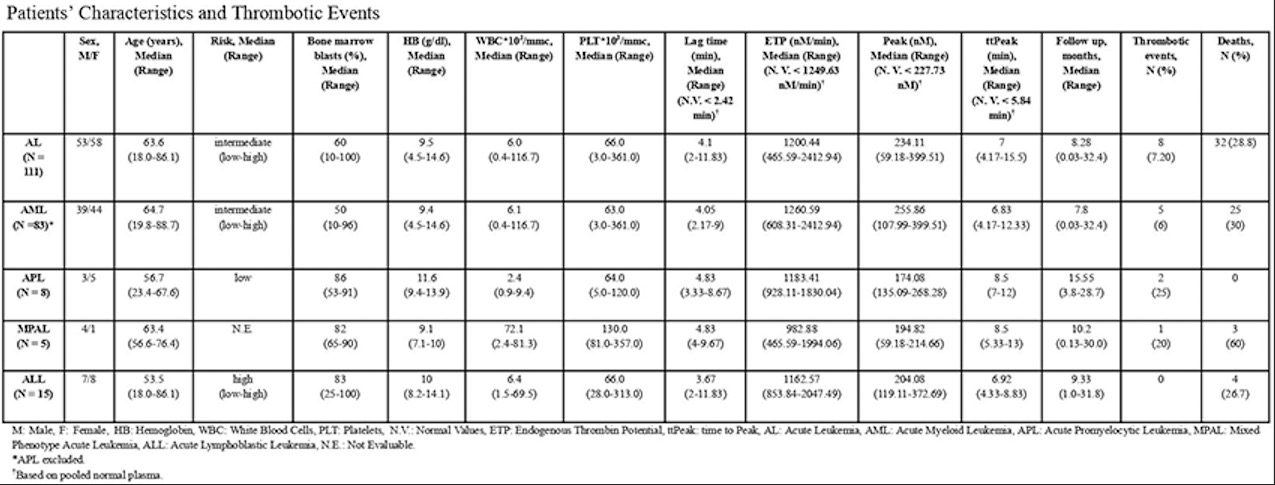Abstracts from the 29^ National Conference of the Italian Society for the Study of Hemostasis and Thrombosis, Bergamo, Italy | 23-25 October 2025
Vol. 4 No. s1 (2025)
PO25 | Baseline thrombin generation test does not predict thrombotic events in acute leukemia: a monocentric prospective study
M. Biglietto, R. Mormile, M.L. Bisegna, A. Laganà, A. L. Faccini, A. Papa, E. Baldacci, C. Santoro, M.S. De Propris, A. Chistolini | Hematology, Department of Translational and Precision Medicine Sapienza University of Roma, Italy
Publisher's note
All claims expressed in this article are solely those of the authors and do not necessarily represent those of their affiliated organizations, or those of the publisher, the editors and the reviewers. Any product that may be evaluated in this article or claim that may be made by its manufacturer is not guaranteed or endorsed by the publisher.
All claims expressed in this article are solely those of the authors and do not necessarily represent those of their affiliated organizations, or those of the publisher, the editors and the reviewers. Any product that may be evaluated in this article or claim that may be made by its manufacturer is not guaranteed or endorsed by the publisher.
Published: 22 October 2025
368
Views
0
Downloads
Similar Articles
- PO39 | Bleeding events in Von Willebrand disease type 1 yearly treatable with desmopressin , Bleeding, Thrombosis and Vascular Biology: Vol. 4 No. s1 (2025)
- PO67 | Pancreatic cancer in a 71-year-old severe hemophilia A patient with inhibitors and sustained zero bleeding during emicizumab prophylaxis , Bleeding, Thrombosis and Vascular Biology: Vol. 4 No. s1 (2025)
- PO04 | Classification criteria for antiphospholipid syndrome: ACR/EULAR 2023 versus Sydney 2006 – A monocentric and retrospective study , Bleeding, Thrombosis and Vascular Biology: Vol. 4 No. s1 (2025)
- PO40 | Management of paediatric patients affected by mild factor VII deficiency undergoing surgery , Bleeding, Thrombosis and Vascular Biology: Vol. 4 No. s1 (2025)
- PO68 | Whole blood hypercoagulable profiles in a patient with markedly elevated lipoprotein(A) plasma levels and thrombotic complications: a case report , Bleeding, Thrombosis and Vascular Biology: Vol. 4 No. s1 (2025)
- PO05 | Intensive FVIII replacement in haemophilia patients with hypertrophic synovium: a randomized study , Bleeding, Thrombosis and Vascular Biology: Vol. 4 No. s1 (2025)
- PO06 | Extracellular vesicles profiles in patients with porto-sinusoidal vascular disease , Bleeding, Thrombosis and Vascular Biology: Vol. 4 No. s1 (2025)
- PO41 | Comparison of the haemorrhagic phenotype between female and male patients affected by autosomal inherited bleeding disorders in a single-centre cohort , Bleeding, Thrombosis and Vascular Biology: Vol. 4 No. s1 (2025)
- PO69 | Whole blood thrombin generation hypercoagulable profile in a patient with hemolytic crisis due to paroxysmal nocturnal hemoglobinuria: a case report , Bleeding, Thrombosis and Vascular Biology: Vol. 4 No. s1 (2025)
- PO07 | Liver transplant in a case of congenital afibrinogenemia , Bleeding, Thrombosis and Vascular Biology: Vol. 4 No. s1 (2025)
1-10 of 96
Next
You may also start an advanced similarity search for this article.











